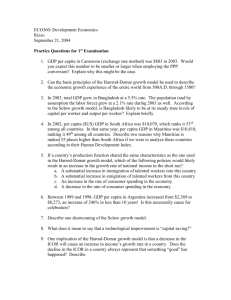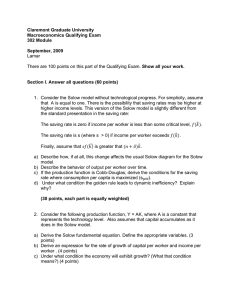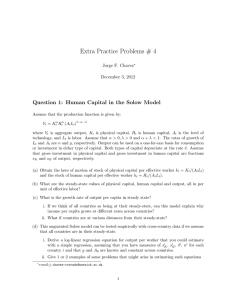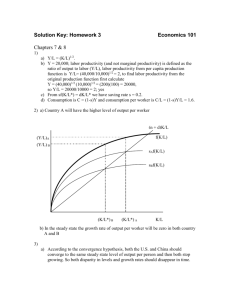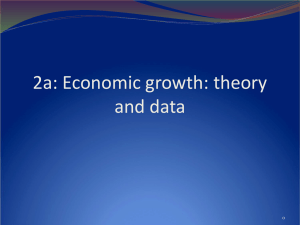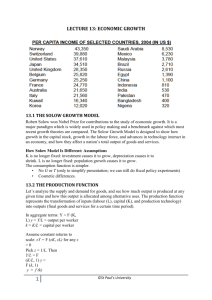GROWTH THEORY HANDOUT Assume for simplicity no
advertisement
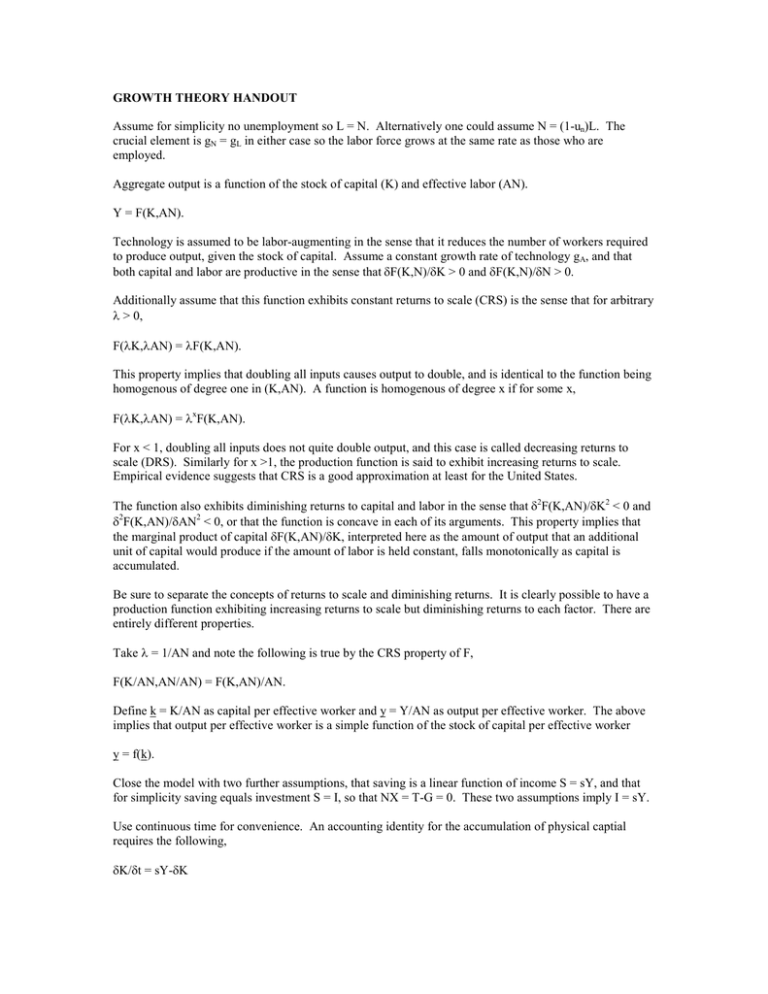
GROWTH THEORY HANDOUT Assume for simplicity no unemployment so L = N. Alternatively one could assume N = (1-un)L. The crucial element is gN = gL in either case so the labor force grows at the same rate as those who are employed. Aggregate output is a function of the stock of capital (K) and effective labor (AN). Y = F(K,AN). Technology is assumed to be labor-augmenting in the sense that it reduces the number of workers required to produce output, given the stock of capital. Assume a constant growth rate of technology gA, and that both capital and labor are productive in the sense that δF(K,N)/δK > 0 and δF(K,N)/δN > 0. Additionally assume that this function exhibits constant returns to scale (CRS) is the sense that for arbitrary λ > 0, F(λK,λAN) = λF(K,AN). This property implies that doubling all inputs causes output to double, and is identical to the function being homogenous of degree one in (K,AN). A function is homogenous of degree x if for some x, F(λK,λAN) = λxF(K,AN). For x < 1, doubling all inputs does not quite double output, and this case is called decreasing returns to scale (DRS). Similarly for x >1, the production function is said to exhibit increasing returns to scale. Empirical evidence suggests that CRS is a good approximation at least for the United States. The function also exhibits diminishing returns to capital and labor in the sense that δ2F(K,AN)/δK2 < 0 and δ2F(K,AN)/δAN2 < 0, or that the function is concave in each of its arguments. This property implies that the marginal product of capital δF(K,AN)/δK, interpreted here as the amount of output that an additional unit of capital would produce if the amount of labor is held constant, falls monotonically as capital is accumulated. Be sure to separate the concepts of returns to scale and diminishing returns. It is clearly possible to have a production function exhibiting increasing returns to scale but diminishing returns to each factor. There are entirely different properties. Take λ = 1/AN and note the following is true by the CRS property of F, F(K/AN,AN/AN) = F(K,AN)/AN. Define k = K/AN as capital per effective worker and y = Y/AN as output per effective worker. The above implies that output per effective worker is a simple function of the stock of capital per effective worker y = f(k). Close the model with two further assumptions, that saving is a linear function of income S = sY, and that for simplicity saving equals investment S = I, so that NX = T-G = 0. These two assumptions imply I = sY. Use continuous time for convenience. An accounting identity for the accumulation of physical captial requires the following, δK/δt = sY-δK (δK/δt)*(K/K)/AN = sY/AN - δK/AN (1/K)*(δK/δt)*k = sy - δk. Note that (δk/δt)/k = (δK/δt)/K – (δA/δt)/A – (δN/δt)/N. Rearranging and plugging into the expression above, using (δA/δt)/A = gA and (δN/δt)/N = gN, δk/δt – (gA + gN)k = sy - δk. This yields the final equation for capital accumulation in our economy, δk/δt = sf(k) - (gA + gN + δ)k Note this equation is a generic case of the simple Solow model of Chapter 23 where gA = gN = 0. The steady-state is defined where the LHS is zero, so there is no more accumulation of capital per effective worker so that saving per effective worker sf(k) equals “depreciation” of the of the effective capital stock (gA + gN + δ)k. The level of effective captial to which the economy converges is described by the intersection of these two curves. The steady-state is defined by the following properties. The growth rate of capital and output per effective worker is zero since they converge to values satisfying the equation above. The growth rate of output per effective worker can be decomposed as follows, (δy/δt)/y = (δy/δt)/y – gA, where y = Y/N is per capita output. Since the growth rate of y is zero, per capita income must grow at the same rate as technology. The growth rate of per capita output can be similarly decomposed as follows, (δy/δt)/y = (δY/δt)/Y – gN. As per capita ouput grows at rate gA it follows that output grows at rate gA + gN. Finally, note that effective labor AN grows at the same rate as output Y. The CRS and diminishing returns properties of the production function require that the stock of capital K be growing at the same rate. A similar argument can be made so that the stock of capital per capita (K/N) grows at the same rate of output per capita and technology, gA. As output and the two inputs grow at the same rate in steady-state, this economy is said to exhibit balanced growth. The CRS production function and growth rate of effective labor suggest looking for a solution where output, capital, and effective labor all grow at the same rate gA + gN. Solving the model requires using variables which converge in some steady-state, so normalizing capital or output only by population will not work, as these variables will grow with technology. As an example of something that does not work, use the original Solow solution. Denote capital per capita by k. Simply normalize the original capital accumulation equation δK/δt = sY-δK by N, as was done in the simple Solow model. It directly follows that (δk/δt) will never be zero and the curves sf(k,A) and (δ + gN)k will never intersect in steady-state because technical progress keeps shifting the saving curve upward every period. Note, however, that the normalizations Y/AN and K/AN yield objects which do not grow in the long-run, and permit construction of a solution to the problem and curves which do not change every time period. This solution is the one detailed above.

